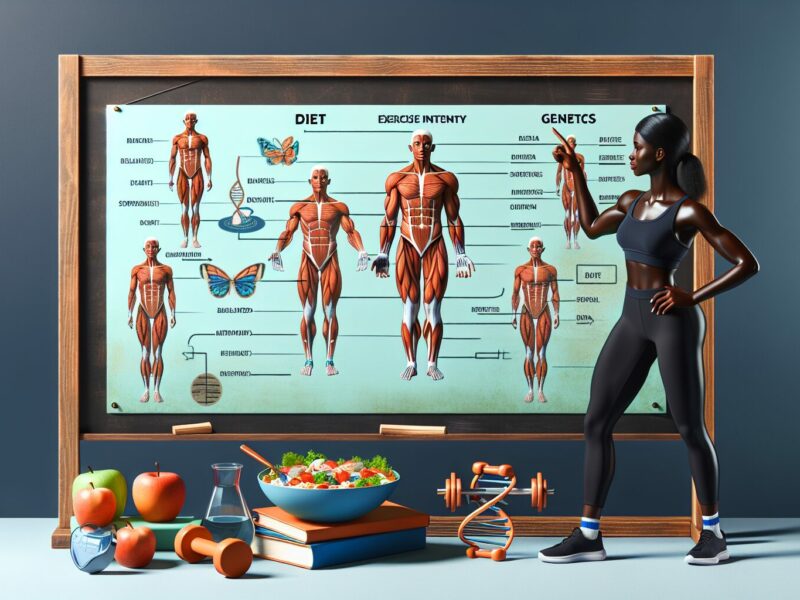Have you ever wondered how long it takes for your hard work at the gym to result in visibly bigger muscles? The answer to this question is not as straightforward as we might hope. While there is no definitive timeline for muscle growth, several factors can influence the speed at which your muscles become visually bigger. From genetics to training intensity, this article explores the various elements that contribute to muscle growth and provides some general guidelines to help you understand what to expect on your fitness journey. So, let’s dive into the fascinating realm of muscle growth and discover how your dedication can eventually pay off in the mirror.

Factors Affecting Muscle Growth
Muscle growth, also known as muscle hypertrophy, is influenced by various factors. Understanding these factors can help maximize your efforts in building muscle. Here are the key factors that affect muscle growth:
Genetics
Genetics play a significant role in determining your muscle growth potential. Some individuals have naturally higher levels of muscle-building hormones or more efficient muscle fiber types, which can contribute to quicker gains in muscle mass. While genetics may set the foundation, it’s important to remember that anyone can make progress with the right training and nutrition.
Gender
Gender can also impact muscle growth. Generally, men tend to have higher levels of testosterone, a hormone that promotes muscle growth. Testosterone helps increase protein synthesis and the production of new muscle tissue. Women, on the other hand, have relatively lower testosterone levels, making muscle growth a bit more challenging. However, women can still build significant muscle with the appropriate training and nutrition.
Age
Age is another crucial factor to consider when it comes to muscle growth. In general, muscle growth tends to be easier during adolescence and early adulthood when hormone levels are high. As you age, hormonal changes, including a decrease in testosterone and growth hormone, can make muscle growth more challenging. However, regular resistance training and proper nutrition can help counteract the effects of aging and promote muscle growth at any age.
Nutrition
Nutrition plays a fundamental role in muscle growth. To build and repair muscle tissue, your body needs an adequate supply of essential nutrients. Consuming enough protein is particularly important as it provides the building blocks (amino acids) necessary for muscle synthesis. Aim for a balanced diet that includes lean sources of protein, carbohydrates for energy, and healthy fats. Additionally, ensure you’re meeting your daily caloric needs, as a caloric surplus can support muscle growth.
Training Program
Your training program is a crucial determinant of muscle growth. Resistance training, such as weightlifting, stimulates muscle fibers, triggering the adaptation process that leads to muscle growth. It’s important to structure your program with a combination of different exercises, target different muscle groups, and gradually increase the intensity and volume over time. Progressive overload, which involves continually challenging your muscles with heavier weights or increased repetitions, is key to stimulating muscle growth.
Initial Changes in Muscles
When you start a muscle-building program, there are some immediate changes that occur within your muscles. These changes pave the way for future muscle growth. Here are the initial changes you can expect:
Increased Blood Flow
As you begin exercising, blood flow to your muscles increases. This increased blood flow brings more oxygen and nutrients to the muscles, promoting their overall health and function. The enhanced circulation also helps remove waste products, such as lactic acid, which can cause muscle fatigue.
Muscle Pump
During and after your workout, you may experience a muscle pump, also known as the “pump effect.” This sensation occurs when blood rushes into the working muscles, causing them to swell and feel tight. The muscle pump is temporary, but it signifies increased blood flow and nutrient delivery, which supports muscle growth.
Temporary Inflammation
After a challenging workout, you may also experience temporary inflammation within your muscles. This inflammation is a natural response to exercise-induced muscle damage. While it may cause some discomfort, it plays a crucial role in initiating the muscle repair process. Over time, this inflammation subsides as your body repairs and rebuilds muscle tissue, leading to muscle growth.
Short-Term Muscle Growth
In the initial stages of your muscle-building journey, you may notice some short-term muscle growth. Although these changes are not long-lasting, they can give you an immediate sense of progress. Here are the short-term effects of muscle growth:
Muscle Pump Effect
As mentioned earlier, the muscle pump effect leads to a temporary increase in muscle size. This effect is particularly noticeable during and immediately after resistance training exercises. The muscle pump can enhance muscle definition and make your muscles appear larger, even though it’s not permanent.
Temporary Swelling from Fluid Retention
Another short-term effect of muscle growth is temporary swelling or bloating due to fluid retention. During intense workouts, your muscles may retain water, causing them to appear fuller and larger. While this may be exciting to see, it’s important to note that this swelling is temporary and not actual muscle gain.
Improved Muscle Definition
As you engage in regular resistance training, your muscles become more defined and sculpted. While this may not necessarily equate to significant muscle growth, it can enhance the appearance of your muscles. Improved muscle definition occurs due to a combination of factors, including reduced body fat, increased muscle tone, and better muscle separation.
Long-Term Muscle Growth
Long-term muscle growth refers to the gradual and sustainable increase in muscle size and strength. Building muscle takes time and consistent effort. Here are the key mechanisms involved in long-term muscle growth:
Hypertrophy
Hypertrophy is the process in which individual muscle fibers increase in size, resulting in an overall increase in muscle mass. Hypertrophy can occur through two main mechanisms: sarcoplasmic hypertrophy and myofibrillar hypertrophy.
Sarcoplasmic Hypertrophy
Sarcoplasmic hypertrophy refers to an increase in the fluid (sarcoplasm) and energy stores within the muscle fibers. This type of hypertrophy leads to a larger, more rounded muscle appearance. It is commonly associated with higher repetitions and shorter rest periods during resistance training.
Myofibrillar Hypertrophy
Myofibrillar hypertrophy, on the other hand, involves an increase in the contractile proteins (myofibrils) within the muscle fibers. This type of hypertrophy leads to increased muscle density and strength. Myofibrillar hypertrophy is typically stimulated by heavy resistance training with lower repetitions and longer rest periods.
Satellite Cell Activation
Satellite cells are essential for muscle growth and repair. These cells are activated in response to resistance training and contribute to the repair and growth of damaged muscle fibers. Satellite cell activation plays a crucial role in adapting to increased training demands and promoting long-term muscle growth.
Muscle Protein Synthesis
Muscle protein synthesis is the process of building new muscle proteins from amino acids. Resistance training stimulates muscle protein synthesis, particularly when combined with an adequate supply of dietary protein. Ensuring you consume enough protein, especially around your workouts, optimizes muscle protein synthesis and supports muscle growth.
Strength Gains
As your muscles grow, they also become stronger. Building muscle is closely tied to strength gains. Increasing resistance gradually over time, known as progressive overload, challenges your muscles, stimulating further growth. Improvements in strength are a good indicator of long-term muscle growth.

Timeline of Muscle Growth
Muscle growth is not an overnight process. It takes time and consistent effort to see noticeable changes. Understanding the timeline of muscle growth can help manage your expectations and stay motivated. Here’s a general overview of what to expect:
Immediate Changes
As mentioned earlier, immediate changes occur during or immediately after your workout. These changes include increased blood flow, muscle pump, and temporary inflammation. While these changes may make your muscles appear larger or more defined, they are temporary and not indicative of long-term muscle growth.
Initial Muscle Gain
In the first few weeks of consistent resistance training and proper nutrition, you may experience initial muscle gain. This initial muscle gain is primarily due to muscle glycogen and fluid retention. While it’s exciting to see progress, keep in mind that this initial gain is relatively small compared to what is achievable with long-term muscle growth.
Steady Progress
Following the initial muscle gain, you can expect to see steady progress in muscle growth. With continued resistance training and proper nutrition, muscle fibers undergo hypertrophy, resulting in increased muscle size and strength. Consistency is key during this phase, as muscle growth occurs gradually over weeks and months.
Plateaus
During your muscle-building journey, you may encounter plateaus, periods where your progress seems to stall. Plateaus are a normal part of the muscle growth process and can be caused by various factors, such as insufficient recovery, lack of variation in your training program, or inadequate nutrition. When faced with a plateau, it’s important to reassess and make adjustments to continue progressing.
Maintenance Phase
Once you achieve your desired muscle size and strength, you can transition into a maintenance phase. In this phase, the focus shifts towards maintaining your hard-earned gains rather than actively seeking further muscle growth. A balanced training program, proper nutrition, and consistency are key to maintaining your muscle mass.
Factors That May Affect the Timeline
While the general timeline of muscle growth provides guidance, it’s important to recognize that the rate of progress can vary between individuals. Several factors can influence how quickly you build muscle and how long it takes to see visual changes. Here are some factors that may affect the timeline of muscle growth:
Individual Response to Training
Each individual responds differently to training stimuli. While some people may experience rapid muscle growth, others may make progress at a slower pace. Factors such as training history, muscle fiber composition, and overall fitness level can influence your individual response to training.
Consistency and Effort
Consistency and effort are crucial for optimal muscle growth. Skipping workouts or not giving your best effort during training can slow down progress. Consistently following your training program, staying dedicated to proper nutrition, and maintaining a positive mindset are key to maximizing muscle growth.
Training Intensity
The intensity of your workouts can significantly impact the rate of muscle growth. Higher training intensities, such as lifting heavier weights and pushing yourself to near failure, can stimulate greater muscle adaptations. However, it’s important to find the right balance between challenging yourself and avoiding excessive strain or injury.
Genetics
As mentioned earlier, genetics play a significant role in muscle growth potential. Some individuals may be genetically predisposed to build muscle more quickly or efficiently than others. While you can’t change your genetics, focusing on factors within your control, such as training and nutrition, can still lead to significant muscle growth.
Recovery and Sleep
Adequate recovery is essential for muscle growth. Muscles grow and repair during the rest periods between workouts, not just during the actual training sessions. Ensuring you get enough quality sleep, managing stress levels, and incorporating rest days into your training program are critical for optimal recovery and muscle growth.
Caloric Surplus
To support muscle growth, your body needs to be in a caloric surplus, meaning you consume more calories than you burn. This surplus provides the necessary energy and nutrients for muscle synthesis. However, it’s important to strike a balance and avoid excessive caloric intake, as it can lead to unwanted fat gain alongside muscle growth.

Tips to Optimize Muscle Growth
To optimize your muscle growth, consider implementing the following tips into your fitness routine:
Progressive Overload
Consistently challenge your muscles by progressively increasing the intensity of your workouts. This can be achieved through adding more weight, performing more repetitions, or decreasing rest periods. The principle of progressive overload ensures that your muscles continue to adapt and grow.
Proper Nutrition
Give your body the fuel it needs to build muscle by following a balanced and nutritious diet. Focus on consuming an adequate amount of protein, carbohydrates, and healthy fats. Consider incorporating nutrient-dense foods and timing your meals around your workouts to optimize muscle growth.
Adequate Protein Intake
Protein is the building block of muscle tissue. Aim to consume enough high-quality protein from sources such as lean meats, poultry, fish, dairy, eggs, legumes, and plant-based protein sources. A general guideline is to consume around 0.8-1 gram of protein per pound of bodyweight per day.
Sufficient Rest and Recovery
Allow your muscles time to recover and repair between workouts. Incorporate rest days into your training schedule and prioritize sleep to ensure adequate recovery. Aim for 7-9 hours of quality sleep each night to support muscle growth and overall health.
Balanced Training Program
Design a well-rounded training program that targets all major muscle groups. Include a variety of exercises and training modalities, such as resistance training, cardiovascular exercise, and flexibility work. A balanced program ensures overall muscular development and reduces the risk of imbalances or injuries.
Variation and Periodization
Regularly change up your workouts to prevent plateaus and keep your muscles guessing. Incorporate different exercises, rep ranges, training methods, and training splits into your routine. Additionally, consider periodizing your training by varying the intensity and volume throughout different phases to optimize muscle growth.
Common Misconceptions About Muscle Growth
There are several common misconceptions about muscle growth that can hinder progress or mislead individuals. Let’s debunk some of these myths:
Muscle Turning to Fat
Muscle and fat are two distinct types of tissue, and one cannot directly convert into the other. When you stop training or reduce your activity level, your muscles may shrink (atrophy) due to lack of stimulation. Simultaneously, if you continue consuming the same caloric intake, you may gain fat because of an energy surplus. However, the two processes are separate and independent.
Spot Reduction
Contrary to popular belief, you cannot selectively reduce fat from a specific area through exercise. When you lose fat, it occurs throughout your body in a genetically determined pattern. Similarly, you cannot solely target muscle growth in a particular area by exercising that specific muscle. Building muscle occurs throughout your body in response to overall training stimuli.
Fast Muscle Gain Without Fat Gain
While it’s possible to build muscle mass quickly, it typically comes with some level of fat gain, especially when in a caloric surplus. It’s challenging to gain large amounts of muscle without any concurrent fat gain. However, with proper nutrition, training, and a controlled caloric surplus, you can minimize fat gain while maximizing muscle growth.

Conclusion
Muscle growth is a complex process influenced by several factors, including genetics, gender, age, nutrition, and training program. While genetics and gender set the foundation, anyone can make progress and build muscle with the right approach. Understanding the initial changes, short-term and long-term effects, and the timeline of muscle growth can help manage expectations and stay motivated throughout the journey. By optimizing factors like training intensity, nutrition, recovery, and incorporating effective strategies like progressive overload, you can maximize your muscle growth potential. Remember to avoid common misconceptions and myths surrounding muscle growth and stay consistent in your efforts. With dedication, patience, and the right mindset, you can achieve your desired muscle growth goals.


